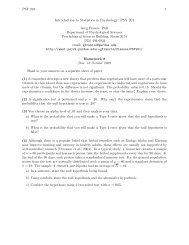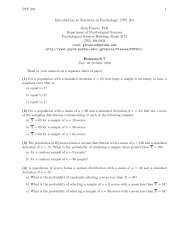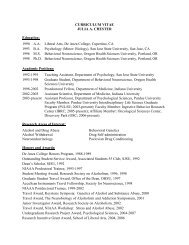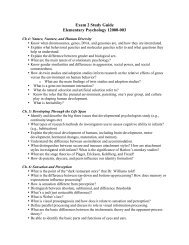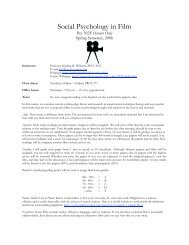Perception - Department of Psychological Sciences
Perception - Department of Psychological Sciences
Perception - Department of Psychological Sciences
Create successful ePaper yourself
Turn your PDF publications into a flip-book with our unique Google optimized e-Paper software.
<strong>Perception</strong><br />
<strong>Perception</strong><br />
Chapter 6<br />
1<br />
Selective Attention<br />
Perceptual Illusions<br />
Perceptual Organization<br />
Form <strong>Perception</strong><br />
Motion <strong>Perception</strong><br />
Perceptual Constancy<br />
2<br />
<strong>Perception</strong><br />
<strong>Perception</strong><br />
Perceptual Interpretation<br />
Sensory Deprivation and<br />
Restored Vision<br />
Perceptual Adaptation<br />
Perceptual Set<br />
<strong>Perception</strong> and Human Factor<br />
The process <strong>of</strong> selecting, organizing, and<br />
interpreting sensory information, which enables us<br />
to recognize meaningful objects and events.<br />
3<br />
4<br />
Selective Attention<br />
<strong>Perception</strong>s about objects change from moment to<br />
moment. We can perceive different forms <strong>of</strong> the<br />
Necker cube; however, we can only pay attention<br />
to one aspect <strong>of</strong> the object at a time.<br />
Example: Cocktail Party Effect<br />
Necker Cube<br />
5<br />
6<br />
1
Inattentional Blindness<br />
Inattentional blindness refers to the inability<br />
to see an object or a person in our midst.<br />
Simmons & Chabris (1999) showed that half<br />
<strong>of</strong> the observers failed to see the gorillasuited<br />
assistant in a ball passing game.<br />
Change Blindness<br />
Change blindness is a form <strong>of</strong> inattentional<br />
blindness in which two-thirds <strong>of</strong> individuals<br />
giving directions failed to notice a change in the<br />
individual asking for directions.<br />
Daniel Simons, University <strong>of</strong> Illinois<br />
7<br />
© 1998 Psychonomic Society Inc. Image provided courtesy <strong>of</strong> Daniel J. Simmons.<br />
8<br />
Perceptual Illusions<br />
Change Blindness Video<br />
Illusions provide good examples in<br />
understanding how perception is organized.<br />
Studying faulty perception is as important as<br />
studying other perceptual phenomena.<br />
9<br />
Which line is longer?<br />
10<br />
Tall Arch<br />
Illusion <strong>of</strong> a Worm<br />
In this picture, the<br />
vertical dimension<br />
<strong>of</strong> the arch looks<br />
longer than the<br />
horizontal<br />
dimension.<br />
However, both are<br />
equal.<br />
11<br />
Rick Friedman/ Black Star<br />
The figure on the right gives the illusion <strong>of</strong> a blue hazy<br />
“worm” when it is nothing else but blue lines identical<br />
to the figure on the left.<br />
© 1981, by permission <strong>of</strong> Christoph Redies and<br />
Lothar Spillmann and Pion Limited, London<br />
12<br />
2
3-D Illusion<br />
Escher Drawing<br />
Reprinted with kind permission <strong>of</strong> Elsevier Science-NL. Adapted from<br />
H<strong>of</strong>fman, D. & Richards, W. Parts <strong>of</strong> recognition. Cognition, 63, 29-78<br />
It takes a great deal <strong>of</strong> effort to perceive this figure in<br />
two dimensions.<br />
13<br />
14<br />
Form <strong>Perception</strong><br />
Organization <strong>of</strong> the visual field into objects<br />
(figures) that stand out from their surroundings<br />
(ground).<br />
Time Savings Suggestion, © 2003 Roger Sheperd.<br />
15<br />
Perceptual Organization<br />
When vision competes with our other<br />
senses, vision usually wins – a phenomena<br />
called visual capture.<br />
16<br />
Visual Capture Example<br />
e.g., movie projector voices (vision overtakes hearing)<br />
This can be true with other senses as well<br />
e.g., finger touch and various tones; feeling like we’re moving when<br />
simply watching an action movie<br />
17<br />
Sensory and <strong>Perception</strong> Blend<br />
How do we form meaningful perceptions from<br />
sensory information?<br />
We organize it!<br />
Gestalt psychologists showed that a figure formed<br />
a “whole” different than its surroundings.<br />
Our brains do a heck <strong>of</strong> a lot more than just merely<br />
register information about the world!<br />
18<br />
3
Gestalt Psychologists: Grouping<br />
After distinguishing the figure from the ground,<br />
our perception needs to organize the figure into<br />
a meaningful form using grouping rules.<br />
Grouping & Reality<br />
Although grouping principles usually help us construct<br />
reality, they may occasionally lead us astray.<br />
Both photos by Walter Wick. Reprinted from GAMES<br />
Magazine. .© 1983 PCS Games Limited Partnership<br />
19<br />
20<br />
• Naturally we look for<br />
patterns in life<br />
• In addition to visual<br />
patterns, we also<br />
concoct patterns with<br />
our other senses<br />
Patterns<br />
Depth <strong>Perception</strong><br />
Depth perception enables us to judge distances.<br />
Gibson and Walk (1960) suggested that human<br />
infants (crawling age) have depth perception. Even<br />
newborn animals show depth perception.<br />
e.g., We tend to hear clock’s go<br />
“tick TICK tick TICK”, but in<br />
reality, the sounds are the<br />
same-“tick tick tick tick”,<br />
Innervisions<br />
21<br />
Visual Cliff<br />
22<br />
Binocular Cues:<br />
Need the use <strong>of</strong> two eyes<br />
Retinal disparity: Images from the two eyes differ. Try<br />
looking at your two index fingers when pointing them<br />
towards each other half an inch apart and about 5 inches<br />
directly in front <strong>of</strong> your eyes. You will see a “finger<br />
sausage” as shown in the inset.<br />
Binocular Cues<br />
Convergence: Neuromuscular cues. When two eyes move<br />
inward (towards the nose) to see near objects and outward<br />
(away from the nose) to see faraway objects.<br />
*Two eyes are better than one!<br />
23<br />
24<br />
4
Monocular Cues:<br />
Can use eyes together or either eye alone<br />
Relative Size: If two objects are similar in size, we<br />
perceive the one that casts a smaller retinal image<br />
to be farther away.<br />
Monocular Cues<br />
Interposition: Objects that occlude (block) other<br />
objects tend to be perceived as closer.<br />
25<br />
Rene Magritte, The Blank Signature, oil on canvas,<br />
National Gallery <strong>of</strong> Art, Washington. Collection <strong>of</strong><br />
Mr. and Mrs. Paul Mellon. Photo by Richard Carafelli.<br />
26<br />
Monocular Cues<br />
Relative Clarity: Because light from distant objects<br />
passes through more light than closer objects, we<br />
perceive hazy objects to be farther away than<br />
those objects that appear sharp and clear.<br />
Monocular Cues<br />
Texture Gradient: Indistinct (fine) texture signals<br />
an increasing distance.<br />
© Eric Lessing/ Art Resource, NY<br />
27<br />
28<br />
Monocular Cues<br />
Monocular Cues<br />
Relative Height: We perceive objects that are higher in our<br />
field <strong>of</strong> vision to be farther away than those that are lower.<br />
Relative motion: Objects closer to a fixation point move<br />
faster and in opposing direction to those objects that are<br />
farther away from a fixation point, moving slower and in<br />
the same direction. This is how we compute objects’<br />
distances.<br />
Image courtesy <strong>of</strong> Shaun P. Vecera, Ph. D.,<br />
adapted from stimuli that appered in Vecrera et al., 2002<br />
29<br />
30<br />
5
Monocular Cues<br />
Monocular Cues<br />
Linear Perspective: Parallel lines, such as railroad<br />
tracks, appear to converge in the distance. The<br />
more the lines converge, the greater their<br />
perceived distance.<br />
© The New Yorker Collection, 2002, Jack Ziegler<br />
from cartoonbank.com. All rights reserved.<br />
31<br />
Light and Shadow: Nearby objects reflect more light into<br />
our eyes than more distant objects. Given two identical<br />
objects, the dimmer one appears to be farther away.<br />
From “Perceiving Shape From Shading” by Vilayaur<br />
S. Ramachandran. © 1988 by Scientific American, Inc.<br />
All rights reserved.<br />
32<br />
Motion <strong>Perception</strong><br />
Motion <strong>Perception</strong>: Objects traveling towards us<br />
grow in size and those moving away shrink in<br />
size. The same is true when the observer moves to<br />
or from an object.<br />
e.g., driving<br />
Apparent Motion<br />
Phi Phenomenon: When lights flash at a certain<br />
speed they tend to present illusions <strong>of</strong> motion.<br />
Neon signs use this principle to create motion<br />
perception.<br />
One light jumping Two lights from flashing one point one to another: after Illusion other. <strong>of</strong> motion.<br />
33<br />
34<br />
Perceptual Constancy<br />
Perceiving objects as unchanging even as<br />
illumination and retinal images change. Perceptual<br />
constancies include constancies <strong>of</strong> shape and size.<br />
Size Constancy<br />
Stable size perception amid changing size <strong>of</strong> the<br />
stimuli.<br />
Shape Constancy 35<br />
36<br />
Size Constancy<br />
6
Size-Distance Relationship<br />
The distant monster (below, left) and the top red<br />
bar (below, right) appear bigger because <strong>of</strong><br />
distance cues.<br />
Size-Distance Relationship<br />
Both girls in the room are <strong>of</strong> similar height.<br />
However, we perceive them to be <strong>of</strong> different<br />
heights as they stand in the two corners <strong>of</strong> the<br />
room.<br />
From Shepard, 1990<br />
Alan Choisnet/ The Image Bank<br />
37<br />
Both photos from S. Schwartzenberg/ The Exploratorium<br />
38<br />
Ames Room<br />
Lightness Constancy<br />
Courtesy Edward Adelson<br />
The Ames room is designed to demonstrate the sizedistance<br />
illusion.<br />
39<br />
The color and brightness <strong>of</strong> square A and B are the same.<br />
40<br />
Color Constancy<br />
Perceiving familiar objects as having consistent<br />
color even when changing illumination filters<br />
the light reflected by the object.<br />
Visual Illusions Video<br />
41<br />
42<br />
Color Constancy<br />
7
Perceptual Interpretation<br />
Immanuel Kant (1724-1804) maintained that<br />
knowledge comes from our inborn ways <strong>of</strong><br />
organizing sensory experiences.<br />
Video Time<br />
What happens when we have sensation<br />
without perception?<br />
John Locke (1632-1704) argued that we learn to<br />
perceive the world through our experiences.<br />
How important is experience in shaping our<br />
perceptual interpretation?<br />
e.g., Amadou Diallo and police incident<br />
43<br />
44<br />
Restored Vision<br />
Facial Recognition<br />
After cataract surgery,<br />
blind adults were able<br />
to regain sight. These<br />
individuals could<br />
differentiate figure and<br />
ground relationships,<br />
yet they had difficulty<br />
distinguishing a circle<br />
and a triangle<br />
(Von Senden, 1932).<br />
After blind adults<br />
regained sight, they were<br />
able to recognize distinct<br />
features, but were unable<br />
to recognize faces.<br />
Normal observers also<br />
show difficulty in facial<br />
recognition when the<br />
lower half <strong>of</strong> the pictures<br />
are changed.<br />
Courtesy <strong>of</strong> Richard LeGrand<br />
45<br />
46<br />
Sensory Deprivation<br />
Perceptual Adaptation<br />
Blakemore & Cooper (1970)<br />
Kittens raised<br />
without exposure to<br />
horizontal lines later<br />
had difficulty<br />
perceiving horizontal<br />
bars.<br />
47<br />
Visual ability to adjust<br />
to an artificially<br />
displaced visual field,<br />
e.g., prism glasses.<br />
Courtesy <strong>of</strong> Hubert Dolezal<br />
48<br />
8
Perceptual Set<br />
A mental predisposition to perceive one thing<br />
and not another. What you see in the center<br />
picture is influenced by flanking pictures.<br />
From Shepard, 1990.<br />
Perceptual Set<br />
Other examples <strong>of</strong> perceptual set.<br />
Frank Searle, photo Adams/ Corbis-Sygma<br />
(a) Loch ness monster or a tree trunk;<br />
(b) Flying saucers or clouds?<br />
Dick Ruhl<br />
49<br />
50<br />
Schemas<br />
Schemas are concepts that organize and<br />
interpret unfamiliar information.<br />
Schemas develop through experience.<br />
Features on a Face<br />
Face schemas are accentuated by specific<br />
features on the face.<br />
Kieran Lee/ FaceLab, <strong>Department</strong> <strong>of</strong> Psychology,<br />
University <strong>of</strong> Western Australia<br />
Courtesy <strong>of</strong> Anna Elizabeth Voskuil<br />
Children's schemas represent reality as well as their<br />
abilities to represent what they see.<br />
51<br />
Students recognized a caricature <strong>of</strong> Arnold<br />
Schwarzenegger faster than his actual photo.<br />
52<br />
Eye & Mouth<br />
Context Effects<br />
Eyes and mouth play a dominant role in face<br />
recognition.<br />
Context can radically alter perception.<br />
Courtesy <strong>of</strong> Christopher Tyler<br />
53<br />
Is the “magician cabinet” on the floor or hanging from the<br />
ceiling?<br />
54<br />
9
Cultural Context<br />
Context instilled by culture also alters<br />
perception.<br />
<strong>Perception</strong> Revisited<br />
Is perception innate or acquired?<br />
To an East African, the woman sitting is balancing a metal<br />
box on her head, while the family is sitting under a tree.<br />
55<br />
56<br />
<strong>Perception</strong> & Human Factors<br />
Human Factor Psychologists design machines that<br />
assist our natural perceptions.<br />
Human Factors & Misperceptions<br />
Understanding human factors enables us to<br />
design equipment to prevent disasters.<br />
Courtesy <strong>of</strong> General Electric<br />
Photodisc/ Punchstock<br />
The knobs for the stove burners on the right are easier to<br />
understand than those on the left.<br />
57<br />
Two-thirds <strong>of</strong> airline crashes caused by human error are<br />
largely due to errors <strong>of</strong> perception.<br />
58<br />
Human Factors in Space<br />
To combat conditions <strong>of</strong> monotony, stress, and<br />
weightlessness when traveling to Mars, NASA<br />
engages Human Factor Psychologists.<br />
Is There Extrasensory <strong>Perception</strong>?<br />
<strong>Perception</strong> without sensory input is called<br />
extrasensory perception (ESP). A large percentage<br />
<strong>of</strong> scientists do not believe in ESP.<br />
Claims <strong>of</strong> ESP<br />
Premonitions or Pretensions<br />
Putting ESP to Experimental Test<br />
Transit Habituation (Transhab), NASA 59<br />
60<br />
10
Claims <strong>of</strong> ESP<br />
Paranormal phenomena include astrological<br />
predictions, psychic healing, communication with<br />
the dead, and out-<strong>of</strong>-body experiences, but most<br />
relevant are telepathy, clairvoyance, and<br />
precognition.<br />
Claims <strong>of</strong> ESP<br />
Telepathy: Mind-to-mind communication. One<br />
person sending thoughts and the other<br />
receiving them.<br />
Clairvoyance: <strong>Perception</strong> <strong>of</strong> remote events,<br />
such as sensing a friend’s house on fire.<br />
Precognition: Perceiving future events, such as<br />
a political leader’s death.<br />
61<br />
62<br />
Putting ESP to Experimental Test<br />
In an experiment with 28,000 individuals,<br />
Wiseman attempted to prove whether or not one<br />
can psychically influence or predict a coin toss.<br />
People were able to correctly influence or predict<br />
a coin toss 49.8% <strong>of</strong> the time.<br />
63<br />
Premonitions or Pretensions?<br />
Can psychics see the future?<br />
Can psychics aid police in<br />
identifying locations <strong>of</strong><br />
dead bodies? What about<br />
psychic predictions <strong>of</strong> the<br />
famous Nostradamus?<br />
The answers to these<br />
questions are NO!<br />
Nostradamus’ predictions<br />
are “retr<strong>of</strong>itted” to events<br />
that took place after his<br />
predictions.<br />
64<br />
Review Session<br />
for Exam 2<br />
Wednesday, Feb 13 th<br />
5:30-6:30pm<br />
Location: In this room<br />
Bring Questions!<br />
65<br />
11


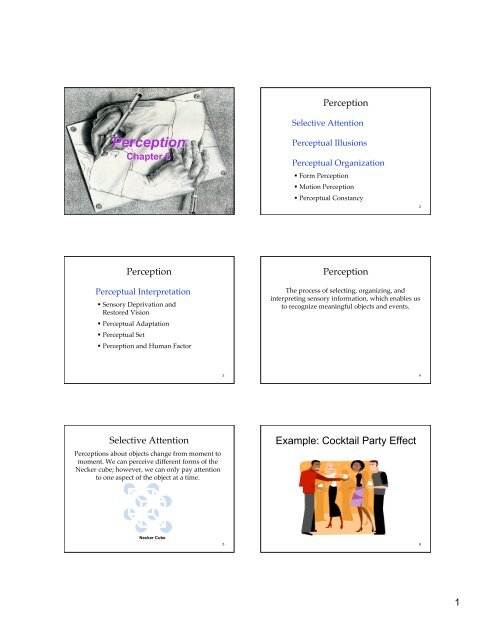
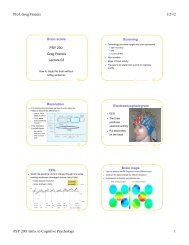

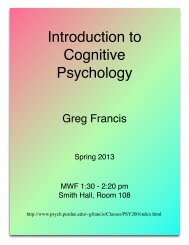
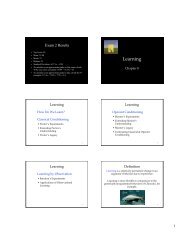
![Exam 4 Study Guide[1]](https://img.yumpu.com/45196739/1/190x245/exam-4-study-guide1.jpg?quality=85)

